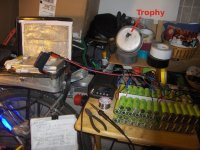arkmundi
10 MW
Here's a picture of the first major test of the new battery build, with all the soldering and wiring done. Yea, that's my trophy, an aluminium camp plate I use during soldering operations. Haahahaa! Was putting a spot of solder on the bullet connectors as the crimping just wasn't strong enough to pull them apart without stripping the wire out. Made contact and always enjoy the fireworks, after the fact. Didn't even phase the battery one bit, but enough current to melt the aluminium. Hahahhaaa.

Next up, I'll be making a custom box for the battery and attaching it to my ebike, taking the first ride, will be the second major test.

Next up, I'll be making a custom box for the battery and attaching it to my ebike, taking the first ride, will be the second major test.

